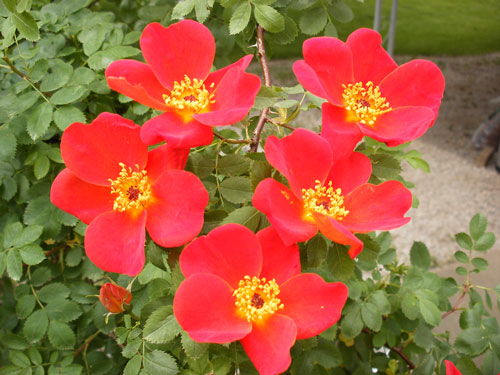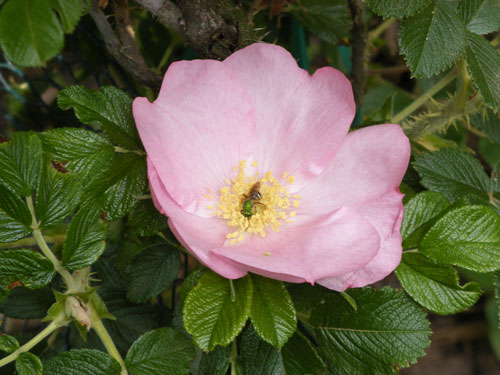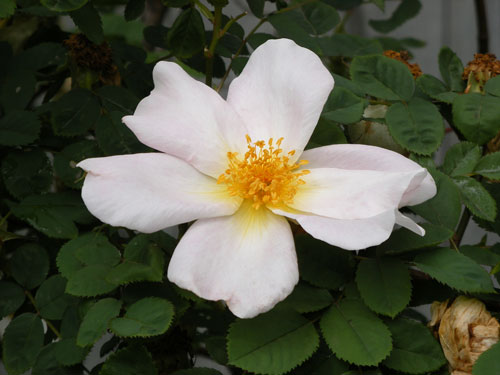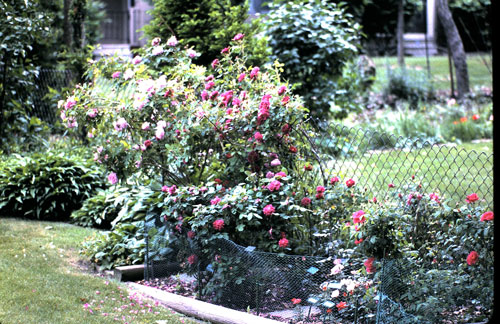

Memory triggers fascinate me, especially fragrance triggers. Have you ever caught the whisper of a fragrance on the wind and been taken back in time? Last night Dr. Tony Liberta, retired biology professor from the State of Illinois University at Normal did a presentation at the Stephen F. Decatur Rose Society meeting in Decatur, Illinois. Old Garden Roses (OGR’s) are defined by the American Rose Society as a variety classified as belonging to one of the 23 rose classes in existence prior to 1867, which he likes to call Antique Roses. His presentation magically swept me back in time to Beach Park in northern Illinois and to thoughts of a little pink Old Garden Rose. I realized last night that I loved that little rose. I think about it often and fondly.
We lived off of Beach Road on a dead end street one mile from Lake Michigan. Can you imagine a street where the trees formed an arbor like a cathedral when you look up? That was Beach Road. I see Beach Road now through my mother’s eyes having grown up in West Texas. Sand storms and cotton, hot, dry, West Texas. Now they might say, oil baby, oil. She used to say to me “Suzy, it’s a lot easier to get warm than cool off!” This was sacrilege. She was a Texan, born and raised and she liked Illinois better. She didn’t like the heat, period. I may have mentioned this but it bears repeating. When I was transferred to Texas I asked Mother to come with me. Her reply was classic. “I got out of there once.” At any rate I digress. At the entrance of the circle drive Mother planted that little pink rose that bloomed only in the springtime. It could have been R. sericea pteracantha, with the classic 4 petals but I don’t remember it having the beautiful red thorns Dr. Liberta showed us last night, which is a signature of this rose. I wish I knew what it was I would plant one tomorrow. The fragrance was intoxicating.Â

This is a true characteristic of Old Garden Roses. They have the most beautiful intense fragrance. Dr. Liberta described that of course most OGR’s only bloom in the spring.
As hybrid perpetual’s came on the scene in the 1800’s, which were repeat blooming roses, OGR’s became less popular. Then modern roses came along and replaced hybrid perpetuals. Isn’t it funny, though that little rose only bloomed in the spring how I then scoffed at why anyone would want it for that reason, now I would love to have that little pink single rose from my childhood. Â

One of the fascinating facts about Dr. Liberta’s presentation is that the origin of many of the yellow roses we have today is an OGR species rose called Rosa foetida and of course it is still grown today. Dr. Liberta said although some OGR’s can be prone to blackspot these roses especially the species roses have survived blackspot and yet thrived for millions of years unlike modern varieties that can be weakened by blackspot.
Hybrid Rugosas for Low Maintenance
If you want easy care here’s a thought Dr. Liberta shared with us, Hybrid Rugosa’s actually are very tough, rugged and resistant to black spot. Here are some varieties he said are good for zone 5A and you can check to see if they are good for your zone before you purchase them. Here are a few places that have Old Garden Roses that Dr. Liberta mentioned and I am familiar with. Of course there are others. I called several of the nurseries below but was only able to locate Nevada at High Country Roses. I spoke to Matt at High Country Roses who offered outstanding customer service. Dr. Liberta had listed High Country Roses on his list and this is my first experience with them so I am very pleased to discover them.
Old Garden | Antique Rose Nureseries
High Country Roses  800–522- 2082 All roses ship in one quart containers | offer 10% discount to all American Rose Society Members | Had in stock difficult to find Nevada when I ordered 7 on May 1st 🙂
Blanc Double de Coubert   white                        Tall               Repeat Blooming
Therese Bugnet                    med.Pink                   Tall              Repeat Blooming
Delicata                                 light pink                    Tall              Repeat Blooming
Hansa                                    med. red                      Tall              Repeat Blooming
Dagmar Hastrup                light pink                      Tall              Repeat Blooming
Pictured below in Dr. Liberta’s garden left to right: Salet a med. pink moss rose, Henri Martin a med red moss rose, Rose de Rescht, a deep pink Portland rose
 Fascinating Facts About OGR’s From Dr. Liberta’s Presentation
Fascinating Facts About OGR’s From Dr. Liberta’s Presentation
Species Class ~ Existed at least 30-40 million years ago only in the Northern Hemisphere. Usually once blooming.
Hybrid Gallica Class ~ Popular during the Roman Empire. Fragrant with a diverse array of colors and color patterns. Blooms once in the spring.
Moss Class ~ Several varieties arose as mutations of Damask roses characterized by glandular growths on the calyx and peduncles
Portland Class ~ Extremely fragrant, repeat blooming roses with fully petaled blooms on short peduncles; many with Damask heritage.
Hybrid Moyesh Class (Classic Shrub) Roses in classic shrub group have a very complicated ancestry, blooms range from single petaled to double.
Hybrid Perpetual Class: Blooms are produced most abundantly in the spring, and then sparsely the remainder of the growing season. They were most popular in the early 1900’
Damask Class ~ An ancient group of roses popular with the Roman Empire for their whose intense fragrance.
Bourbon Class ~ The pedigree of this group is complex. And growth may be either bush like or climbing. Some varieties need winter protection.
Hybrid Rugosa Class (Classic Shrub) Easily identified by the thick, tough heavily veined leaves. Bloom all season and are resistant to fungal disease. Produce colorful foliage and hips in the autumn. Varieties range in size from medium to tall.

What sweet memories you helped bring back. I always loved those first pink blossoms in the spring. The promise that winter was officially over. Reason enough to have them. Thanks again.
Hi,
Thank-you for your comment. That is so true. The first signs of spring and that fragrance in the air are truly unforgettable.
Susan
Old Garden Roses are so amazing …. fragrant, beautiful, rich history, stories of survival! So wish I could have heard Dr. Libertia. Thanks for the great recap Susan!
Hi Susan,
I loved your story about your little pink rose. Have you gone back to Beach Road to see if any of it remains? We have found some old home sites here where the roses live on EVEN after been plowed under! I have one in my backyard that came from such a site. BTW, I have a cutting of ‘Seven Sisters’ started for you.
I need to write that story for you and I will.
: )
Sue
Dear Sue Tiffany, Of ARS & You
I really appreciate your lovely comment. That’s a great idea to go back and see if I could get a clipping of that little single petal pink rose bush.
What an honor to be able to grow and carry on the tradition of the great story of a rose called “Seven Sisters.” I can’t wait to publish your beautiful family story and how a rose keeps you remembering each other and linked to your ancestors and a past filled with sacrifice. It needs to be preserved so people know how their loved ones live on.
Sincerely,
Susan
Opps! Would you add my last name to my comment? I forgot that my e-mail won’t show so no one will know it’s me.
Your cousin,
Sue Tiffany
Thank-you Sue Tiffany of ARS & You!
Sincerely,
Susan